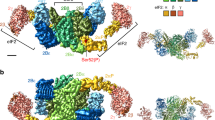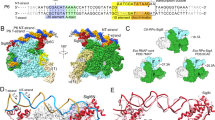Abstract
Receiver domains are the dominant molecular switches in bacterial signalling1,2. Although several structures of non-phosphorylated receiver domains have been reported3,4,5,6,7,8, a detailed structural understanding of the activation arising from phosphorylation has been impeded by the very short half-lives of the aspartyl-phosphate linkages. Here we present the first structure of a receiver domain in its active state, the phosphorylated receiver domain of the bacterial enhancer-binding protein NtrC (nitrogen regulatory protein C). Nuclear magnetic resonance spectra were taken during steady-state autophosphorylation/dephosphorylation, and three-dimensional spectra from multiple samples were combined. Phosphorylation induces a large conformational change involving a displacement of β-strands 4 and 5 and α-helices 3 and 4 away from the active site, a register shift and an axial rotation in helix 4. This creates an exposed hydrophobic surface that is likely to transmit the signal to the transcriptional activation domain.
This is a preview of subscription content, access via your institution
Access options
Subscribe to this journal
Receive 51 print issues and online access
$199.00 per year
only $3.90 per issue
Buy this article
- Purchase on Springer Link
- Instant access to full article PDF
Prices may be subject to local taxes which are calculated during checkout




Similar content being viewed by others
References
Parkinson,J. S. & Kofoid,E. C. Communication modules in bacterial signaling proteins. Annu. Rev. Genet. 26, 71–112 (1992).
Stock,J. B., Surette,M. G., Levit,M. & Park,P. in Two-Component Signal Transduction (eds Hoch, J. A. & Silhavy, T. J.) 25–51 (American Society for Microbiology, Washington DC, 1995).
Stock,A. M., Mottonen,J. M., Stock,J. B. & Schutt,C. E. Three-dimensional structure of CheY, the response regulator of bacterial chemotaxis. Nature 337, 745–749 (1989).
Baikalov,I. et al. Structure of the Escherichia coli response regulator NarL. Biochemistry 35, 11053–11061 (1996).
Volkman,B. F., Nohaile,M. J., Amy,N. K., Kustu,S. & Wemmer,D. E. Three-dimensional solution structure of the N-terminal receiver domain of NTRC. Biochemistry 34, 1413–1424 (1995).
Feher,V. A. et al. High-resolution NMR structure and backbone dynamics of the Bacillus subtilis response regulator, Spo0F: implications for phosphorylation and molecular recognition. Biochemistry 36, 10015–10025 (1997).
Djordjevic,S., Goudreau,P. N., Xu,Q. P., Stock,A. M. & West,A. H. Structural basis for methylesterase CheB regulation by a phosphorylation-activated domain. Proc. Natl Acad. Sci. USA 95, 1381–1386 (1998).
Sola,M., Gomis-Ruth,F. X., Serrano,L., Gonzalez,A. & Coll,M. Three-dimensional crystal structure of the transcription factor PhoB receiver domain. J. Mol. Biol. 285, 675–687 (1999).
Novak,R., Henriques,B., Charpentier,E., Normark,S. & Tuomanen,E. Emergence of vancomycin tolerance in Streptococcus pneumoniae. Nature 399, 590–593 (1999).
Rombel,I., North,A., Hwang,I., Wyman,C. & Kustu,S. in Cold Spring Harbor Symposia on Quantitative Biology: Mechanisms of Transcription (ed. Brown, D.) 157–166 (Cold Spring Harbor Laboratory Press, Cold Spring Harbor, 1998).
Nohaile,M., Kern,D., Wemmer,D., Stedman,K. & Kustu,S. Structural and functional analyses of activating amino acid substitutions in the receiver domain of NtrC: evidence for an activating surface. J. Mol. Biol. 273, 299–316 (1997).
Drake,S. K., Bourret,R. B., Luck,L. A., Simon,M. I. & Falke,J. J. Activation of the phosphosignaling protein CheY. I. Analysis of the phosphorylated conformation by 19F NMR and protein engineering. J. Biol. Chem. 268, 13081–13088 (1993).
Lowry,D. F. et al. Signal transduction in chemotaxis. A propagating conformation change upon phosphorylation of CheY. J. Biol. Chem. 269, 26358–26362 (1994).
Lukat,G. S., McCleary,W. R., Stock,A. M. & Stock,J. B. Phosphorylation of bacterial response regulator proteins by low molecular weight phospho-donors. Proc. Natl Acad. Sci. USA 89, 718–722 (1992).
Hwang,I., Thorgeirsson,T., Lee,J., Kustu,S. & Shin,Y.-K. Physical evidence for a phosphorylation-dependent conformational change in the enhancer-binding protein NtrC. Proc. Natl Acad. Sci. USA 96, 4880–4885 (1999).
Volz,K. Structural conservation in the CheY superfamily. Biochemistry 32, 11741–11753 (1993).
Stock,A. M. et al. Structure of the Mg(2+)-bound form of CheY and mechanisms of phosphoryl transfer in bacterial chemotaxis. Biochemistry 32, 13375–13380 (1993).
Bellsolell,L., Prieto,J., Serrano,L. & Coll,M. Magnesium binding to the bacterial chemotaxis protein CheY results in large conformational changes involving its functional surface. J. Mol. Biol. 238, 489–495 (1994).
Santoro,J., Bruix,M., Pascual,J., López,E., Serrano,L. & Rico,M. 3-Dimensional structure of chemotactic Che-Y protein in aqueous-solution by nuclear-magnetic-resonance methods. J. Mol. Biol. 247, 717–725 (1995).
Feher,V. A. & Cavanagh,J. Millisecond-timescale motions contribute to the function of the bacterial response regulator protein Spo0F. Nature 400, 289–292 (1999).
Krebs,E. G. in The Enzymes (ed. Boyer, P. D. & Krebs, E. G.) 3rd edn Vol. 17 3–20 (Academic, New York, 1986).
Hurley,J. H., Dean,A. M., Thorsness,P. E., Koshland,D. E. Jr & Stroud,R. M. Regulation of isocitrate dehydrogenase by phosphorylation involves no long-range conformational change in the free enzyme. J. Biol. Chem. 265, 3599–3602 (1990).
Russo,A. A., Jeffrey,P. D. & Pavletich,N. P. Structural basis of cyclin-dependent kinase activation by phosphorylation. Nature Struct. Biol. 3, 696–700 (1996).
Canagarajah,B. J., Khokhlatchev,A., Cobb,M. H. & Goldsmith,E. J. Activation mechanism of the MAP kinase ERK2 by dual phosphorylation. Cell 90, 859–869 (1997).
Barford,D., Hu,S. H. & Johnson,L. N. Structural mechanism for glycogen phosphorylase control by phosphorylation and AMP. J. Mol. Biol. 218, 233–260 (1991).
Lin,K., Rath,V. L., Dai,S. C., Fletterick,R. J. & Hwang,P. K. A protein phosphorylation switch at the conserved allosteric site in GP. Science 273, 1539–1542 (1996).
Altieri,A. S., Hinton,D. P. & Byrd,R. A. Association of biomolecular systems via pulsed field gradient NMR self-diffusion measurements. J. Am. Chem. Soc. 117, 7566–7567 (1995).
Güntert,P., Mumenthaler,C. & Wüthrich,K. Torsion angle dynamics for NMR structure calculation with the new program DYANA. J. Mol. Biol. 273, 283–298 (1997).
Koradi,R., Billeter,M. & Wüthrich,K. MOLMOL: A program for display and analysis of macromolecular structures. J. Mol. Graph. 14, 51–55 (1996).
Acknowledgements
We thank D. King for analysis by mass spectrometry. This work was supported by the Director, Office of Biological & Environmental Research, Office of Energy Research of the US Department of Energy, and through instrumentation grants from the NSF D.E.W. would also like to thank the Miller Institute for support during part of this work. NMR studies were carried out at the National Magnetic Resonance Facility at Madison with support from the NIH Biomedical Technology Program and additional equipment funding from the University of Wisconsin, NSF Academic Infrastructure Program, NIH Shared Instrumentation Program, NSF Biological Instrumentation Program, and US Department of Agriculture.
Author information
Authors and Affiliations
Corresponding author
Rights and permissions
About this article
Cite this article
Kern, D., Volkman, B., Luginbühl, P. et al. Structure of a transiently phosphorylated switch in bacterial signal transduction. Nature 402, 894–898 (1999). https://doi.org/10.1038/47273
Received:
Accepted:
Issue Date:
DOI: https://doi.org/10.1038/47273
This article is cited by
-
Importance of time-ordered non-uniform sampling of multi-dimensional NMR spectra of Aβ1–42 peptide under aggregating conditions
Journal of Biomolecular NMR (2019)
-
A pH-gated conformational switch regulates the phosphatase activity of bifunctional HisKA-family histidine kinases
Nature Communications (2017)
-
The σ54-dependent two-component system regulating sulfur oxidization (Sox) system in Acidithiobacillus caldus and some chemolithotrophic bacteria
Applied Microbiology and Biotechnology (2017)
-
A network of molecular switches controls the activation of the two-component response regulator NtrC
Nature Communications (2015)
-
Free energy landscape of activation in a signalling protein at atomic resolution
Nature Communications (2015)
Comments
By submitting a comment you agree to abide by our Terms and Community Guidelines. If you find something abusive or that does not comply with our terms or guidelines please flag it as inappropriate.



